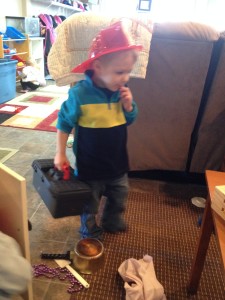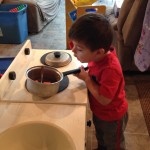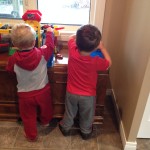Children, Naturally ELCC is a child-centred, play-based program because we know children learn best through play. Our schedule gives the children long blocks of free play time for discovery. There are few transition times to allow them lots of time to create complex play themes as well as the time to act them out. There is also flexibility within the schedule so if children are not ready to transition to another activity; we have the option to extend their play time.
Our program is a multi-age group program meaning children from 1 year to 6 years are together and in turn develop a sense of confidence and competence knowing they are able to help others.
We offer a warm and welcoming home type atmosphere in which all children can feel safe and cared about. We greet each child and their families as they arrive, taking time to talk to each family. Children are seen as individuals and we accept them for who they are. We ensure we spend time with each child everyday, encouraging them and talking with them. This helps us get to know each child on an individual level; their feelings, thoughts, interests, learning styles, developmental levels and abilities. This way we can plan further interactions as well as an environment and activities that meet each child’s development socially, emotionally, physically and cognitively.
We plan our space with the children’s needs in mind. We know children learn best through ‘hands on’ investigations and experiences so learning centres are set up to encourage this discovery and investigation and to support various types of learners. Children can play alone, in small groups, or in larger groups. Our play room is also set up to promote independence. Children are encouraged to think and do for themselves and we are here to assist when needed. We also extend play through discussions and open ended questions. Open ended questions are asked promote creative thinking and encourage children to look at possible solutions ‘outside the box’. These types of questions have no right or wrong answers and they give the child an opportunity to think about the many possibilities.
Our time is filled with planned activities and spontaneous experiences. Activities are often planned and provided after we have observed children. These observations are done during children’s play and we make notes or take photographs of what the children are doing and saying. These notes and photos are studied and reflected on to determine the types of activities that will best extend their play and development.
Planned experiences are activities that we prepare ahead of time such as circle time. For example, we might observe the children’s interest in the pumpkins and their changing colours in our room so plan opening up and digging out the pumpkins for our circle time discussion and activity. This discussion and activity might lead to us making pumpkin pie. From this experience, children learn why pumpkins change from green to orange and we used our senses (sight, smell, touch) when investigate the inside of the pumpkins. In making pumpkin pie the children learn why we follow a recipe, explore math through measuring out ingredients, investigated different ingredients including cinnamon and vanilla, and get to smell and taste the results of their cooperative efforts.
Spontaneous experiences are unexpected activities that happen at the spur of the moment. We enhance or extend the children’s activity and learning at the time it is going on. For example, we might notice the children talking about going to the zoo so we added animals to the block centre. When some children are playing ‘kitty’, we provided pet store accessories in the dramatic play centre. From these experiences, children learn how to care for animals, how to share and how to problem solve when interacting with others.
Children benefit more from the creative process of ‘doing’ than from adult predesigned product based activities. This develops skills such as reasoning and critical thinking. We encourage children to explore and create with a variety of materials often just for the sheer joy of the ‘doing’.
We embrace inclusion and celebrate the diversity in our community such as culture, race, language, religion, socioeconomic status, age, gender and ability. We expose children to similarities and differences by offering a wide variety of books and stories.
We want to support and work with the families in our program as well as their children and we believe open communication is important for this to happen. We provide information to parents about their child’s learning and development through casual conversations at the start and end of each session, newsletters and photos of their children involved in various activities.



